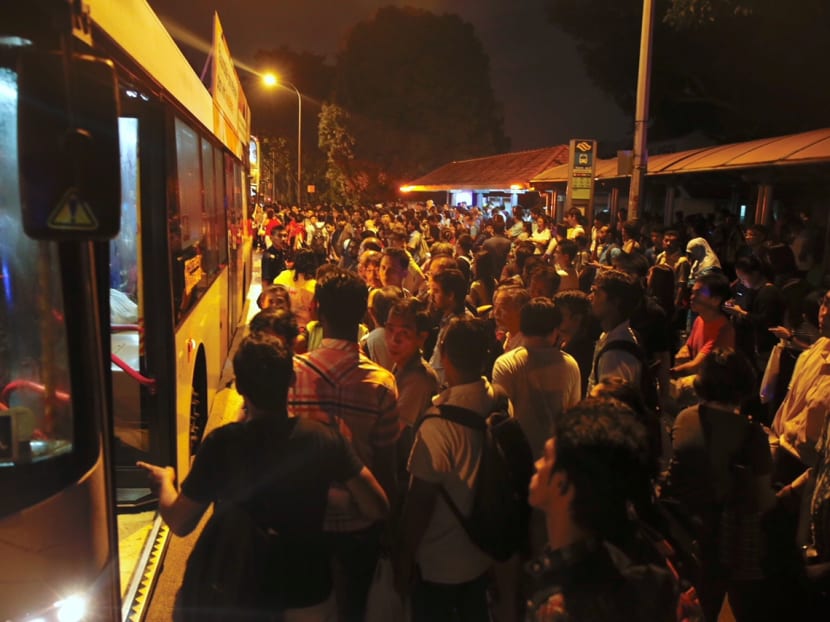How to ease the crowds during major MRT disruptions? Options are limited, experts say
SINGAPORE — The commuting chaos from the massive North-South Line service disruption over the weekend has laid bare the limited options available to the authorities when dealing with sudden surges in demand for alternative public transport, analysts said.

A crowd of commuters wait for free shuttle buses at the bus stop opposite Bishan MRT station after train services from Ang Mo Kio to Marina South Pier were suspended on Oct 7, 2017 due to a flooded train tunnel between Bishan and Braddell stations. Photo by Najeer Yusof/TODAY
SINGAPORE — The commuting chaos from the massive North-South Line service disruption over the weekend has laid bare the limited options available to the authorities when dealing with sudden surges in demand for alternative public transport, analysts said.
Until new rail lines like the Thomson-East Coast Line and newer parts of the Circle Line are operational over the coming years, buses, taxis and private hire cars can only do so much to ease any rapid spike in commuter demand stemming from major MRT breakdowns, they added.
Singapore University of Social Sciences transport economist Walter Theseira said that disruptions to the North-South and East-West Lines — Singapore’s oldest rail lines — are “particularly challenging”, given the lack of substitutes that can transport similarly large numbers of commuters.
On late Saturday evening, large groups of commuters were seen gathering outside Bishan and several other MRT stations along the North-South Line, seeking alternative transport after train services between Bishan and Toa Payoh MRT stations went down.
Rail operator SMRT had halted train services between those stations “as a precaution” due to flooding in the tunnel from Bishan to Braddell MRT stations, following a heavy downpour.
Train services between Newton and Ang Mo Kio stations only resumed on Sunday afternoon, some 20 hours later.
Dr Theseira said the authorities could, in theory, create high capacity bus services that run parallel to the MRT lines as a form of back up. But that would be a costly move.
For most commuters in Singapore, there is only one MRT line they can practicably take, he added. As such, they will not have practical alternatives until new MRT lines are built and the network becomes denser.
National University of Singapore transport researcher Lee Der-Horng agreed. When he was in Tokyo for a week earlier this year, he noticed one particular rail line that broke down almost daily.
“But it didn’t trigger any panic, because from Point A to B you can easily find another line to take. We do not have that luxury here,” he added.
Buses, while often considered the next best alternative when the rail network is down, are simply limited in capacity when compared to trains. Dr Lee noted that about 15 buses are needed for each train that breaks down, which has a maximum capacity of 1,600 passengers.
“Even if you’re able to dispatch a lot of buses, you have the traffic lights and loading and unloading of passengers to deal with,” he said.
SMRT and the Land Transport Authority have yet to provide figures on the number of commuters who were affected by the weekend’s breakdown — possibly the worst disruption since December 2011, when over 200,000 commuters were affected by a major service disruption along the NSL over two days.
Following the latest NSL breakdown, ride-hailing service Uber temporarily suspended surge pricing and encouraged more drivers to go online, while Grab lowered its surge pricing and sent a message to drivers to head to the affected areas to help stranded passengers.
But experts said the ride-hailing services were not effective in addressing the crowd surge. In fact, private car traffic is “the greatest contributor to traffic jams resulting from mass transit disruptions”, noted Dr Theseira.
He added: “Remember that you need two to three dozen cars to transport the same number of people that one public bus can carry – and the number goes up dramatically if the private cars are not filled to capacity.
“You need hundreds of cars to transport the passengers carried in just one MRT train.”
Singapore Management University transport specialist Terence Fan suggested that the authorities relax their rules on carpooling services like GrabHitch during major MRT disruptions, GrabHitch drivers are expected to abide by LTA’s carpooling regulations of not more than two carpooling trips a day.
But if more people could offer spare seats in their cars when transit lines are down, this could go some way towards addressing the problem, he added.








